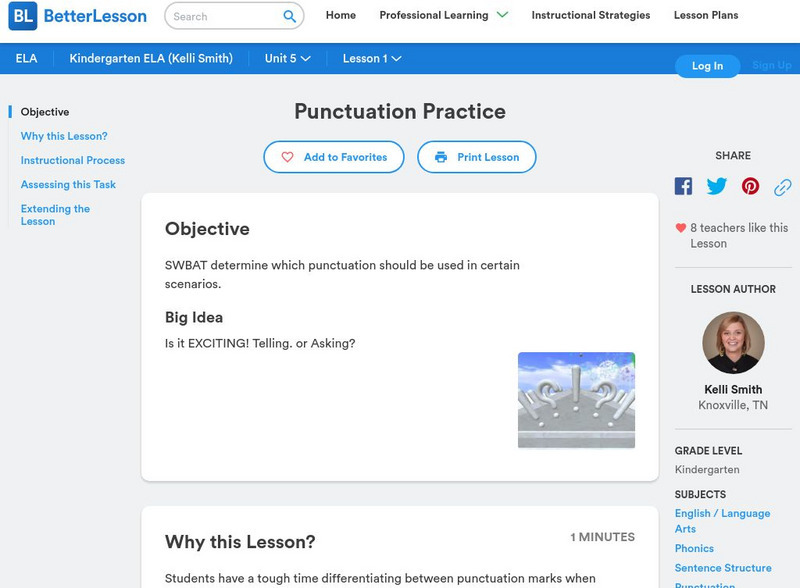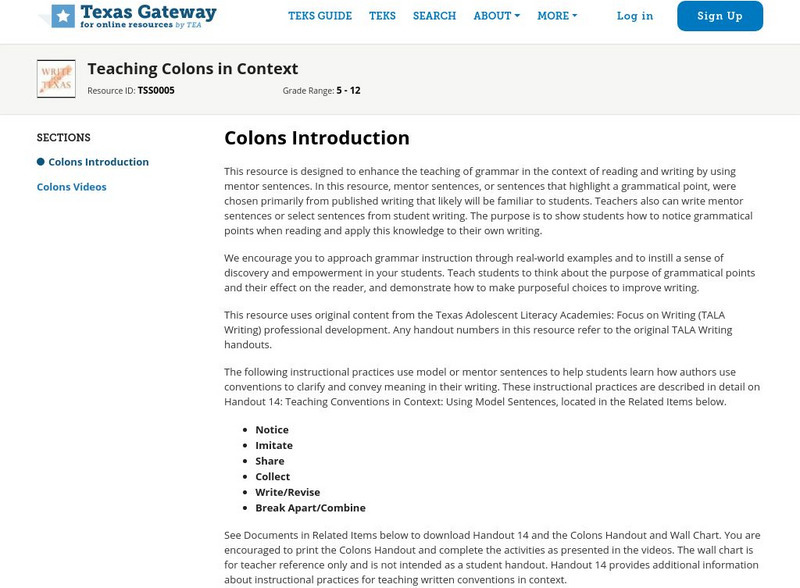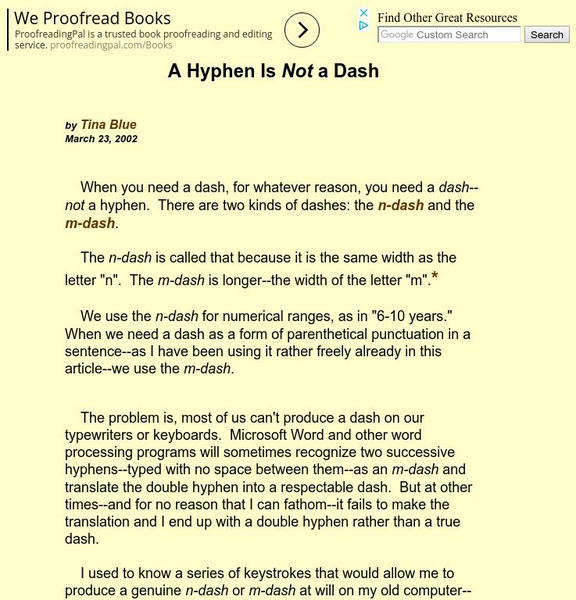Other
Pressbooks: Virginia Western Community College: Let's Get Writing!
This is an open textbook created to assist students in their writing efforts. Topics covered include critical reading, rhetorical analysis, writing arguments, steps in the writing process, rhetorical modes, using credible sources, citing...
Sophia Learning
Sophia: Brackets 8
This slideshow lesson focuses on the use of brackets. It lists 5 uses for brackets and discusses each one separately with examples showing proper use. The 5 uses are as follows: an insertion, within parentheses, a change in a quotation,...
Online Writing Lab at Purdue University
Purdue University Owl: Exercise: Commas After Introductions Exercise 2
This Purdue University OWL (Online Writing Lab) provides practice with adding commas to introductory phrases in sentences.
Texas Education Agency
Texas Gateway: On Track English I Writing: Editing
This site offers links to each section of Writing, Module 8, Lessons 1-9 and Practices 1-3. Students write legibly and use appropriate capitalization and punctuation conventions in their compositions; spell correctly; and edit drafts for...
University of Wisconsin
University of Wisconsin Madison: Writing Center: Grammar and Punctuation
This site provides a grammar reference for students. The rules for using dashes, commas, semicolons, coordinating conjunctions, and conjunctive adverb are included. Topics including subject-verb agreement, how to proofread, and twelve...
Better Lesson
Better Lesson: Punctuation Practice
Students have a tough time differentiating between punctuation marks when writing and especially when reading. It is important that we give students explicit instruction on punctuation to allow them to become more fluent in using them...
Better Lesson
Better Lesson: Write the Room Punctuation
Using a "Write the Room" activity to identify punctuation motivates students to practice this new skill. Students will place punctuation marks in the proper place using clues from signs around the room. Included is a video of the lesson...
Better Lesson
Better Lesson: Who Stole the Cookies From the Cookie Jar?
The ability to identify letters, sounds, words, sentences, and punctuation can help learners become better readers. This lesson utilizes the book "Who Stole the Cookies" for a variety of activities. Included are printable worksheets,...
PBS
Pbs Learning Media: No Nonsense Grammar Collection
In this No Nonsense Grammar Collection, students explore a range of commonly taught grammar principles for elementary and middle schoolers with these short, fun videos and activities. From the difference between dependent and independent...
Texas Education Agency
Texas Gateway: Writing: Editing: Strategies for Editing: Practice 3
A learning module that teaches students about editing their writing in four mini-lessons: Introduction, Avoiding Coma Catastrophes, Placing Quotation Marks, Apostrophes, Em Dashes Like a Pro, and and Putting It All Together.
Texas Education Agency
Texas Gateway: Writing: Editing: Punctuation
A learning module that teaches students about the rules of punctuation in six mini-lessons: Introduction, Terminal Punctuation, The Common Comma, Apostrophes and Quotation Marks, Semicolons, and Your Turn.
Texas Education Agency
Texas Gateway: Teaching Colons in Context
A teaching resource with lesson plans, handouts, and three videos demonstrating how to teach colons with mentor sentences.
Texas Education Agency
Texas Gateway: Teaching Apostrophes in Context
A teaching resource with lesson plans, handouts, and two videos demonstrating how to teach apostrophes in context with mentor sentences.
Texas Education Agency
Texas Gateway: Writing: Editing: Strategies for Editing: Practice 1
A learning module that teaches students about editing strategies in five mini-lessons: Introduction, Spelling Spectacularly, Capitalizing Confidently, Punctuating Perfectly, and Putting It All Together.
English Plus+
Grammar Slammer: Quotation Marks in Direct Quotations
This site discusses what direct quotations are and how to use them.
Capital Community College Foundation
Guide to Grammar and Writing: The Colon
Instructional resource providing notes and examples on the rules of using the colon, including two forms of presentations as well as a quiz where students can apply their understanding of colon usage.
Capital Community College Foundation
Guide to Grammar and Writing: The Ellipsis
Instructional resource providing notes and examples on the rules of using the ellipsis. A quiz link is provided.
Capital Community College Foundation
Guide to Grammar and Writing: The Bracket
Instructional resource providing notes and examples on the rules of using brackets.
Capital Community College Foundation
Guide to Grammar and Writing: The Slash or Virgule
Instructional resource providing notes and examples on the rules of using a slash, also called a virgule, slant or solidus.
Capital Community College Foundation
Guide to Grammar and Writing: Quiz on Comma Usage
This punctuation quiz requires the student to insert necessary commas before comparing his or her version to the possible answers.
Capital Community College Foundation
Guide to Grammar and Writing: The Period
An excellent resource detailing the uses and rules of the grammatical element "the period." Also includes information about the period in sentences, quotation marks, parentheses, and abbreviations.
Capital Community College Foundation
Guide to Grammar and Writing: Using Commas With Introductory Phrases
This online quiz from the Capital Community College is tightly focused on commas and introductory phrases. Ten questions ask the reader to insert commas where necessary, then check the sentence against the website's version. Vocabulary...
Capital Community College Foundation
Guide to Grammar and Writing
A treasure of grammar and writing information. Index links broken down to sentence level, paragraph level, and essay level. Site also contains PDF samples of business writing and research papers, PowerPoint presentations, interactive...
Grammar Tips
Grammar Tips: A Hyphen Is Not a Dash
This resource presents an explanation of the difference between a dash and a hyphen. Discusses the difference between an "n" and "m" dash and how to form each using a word processor.



















